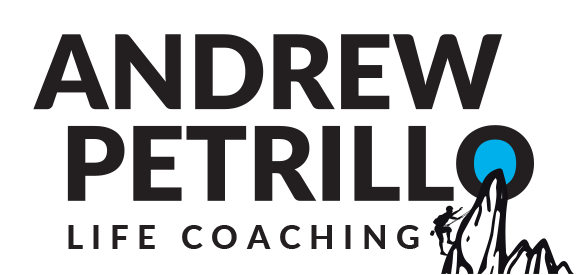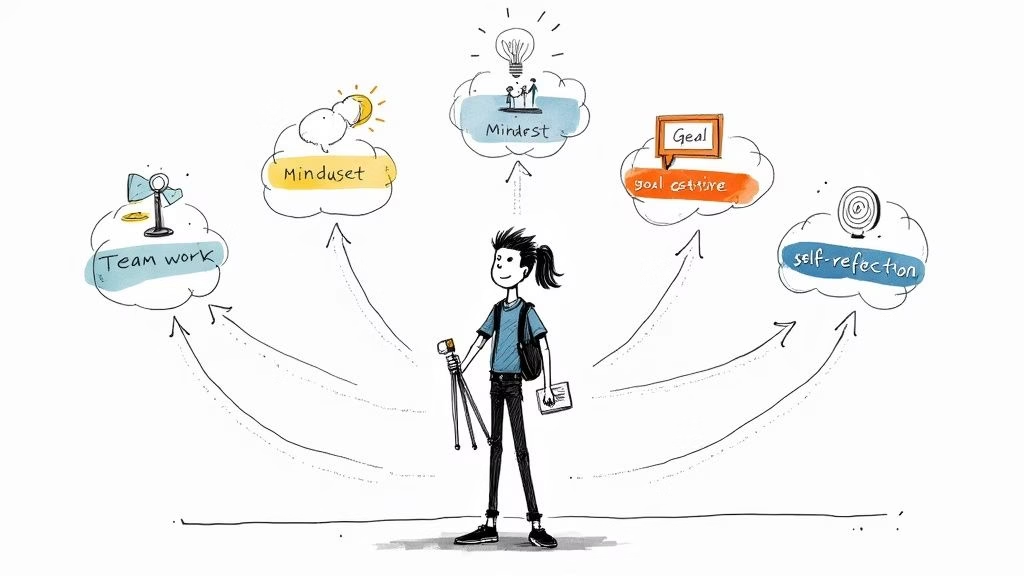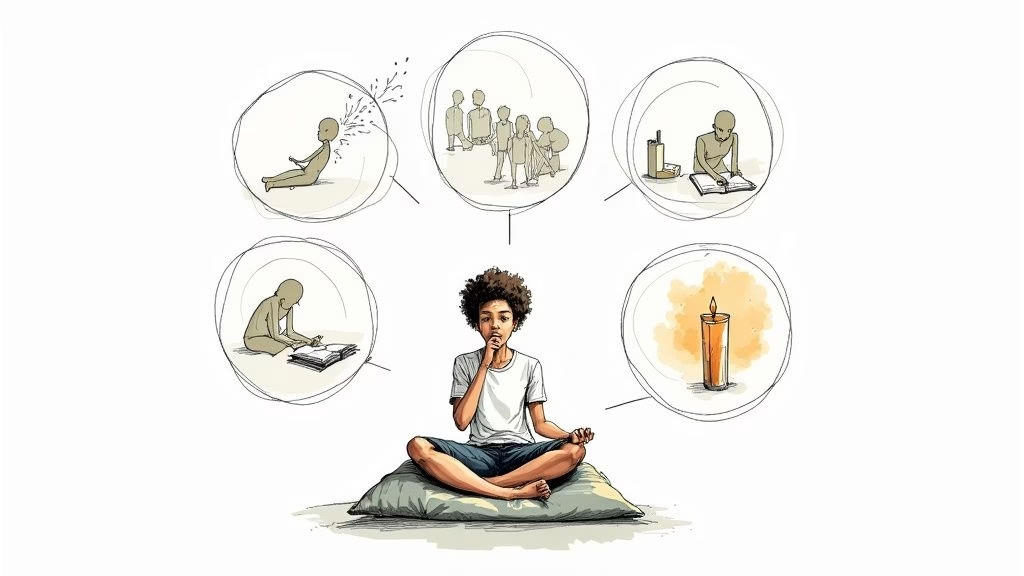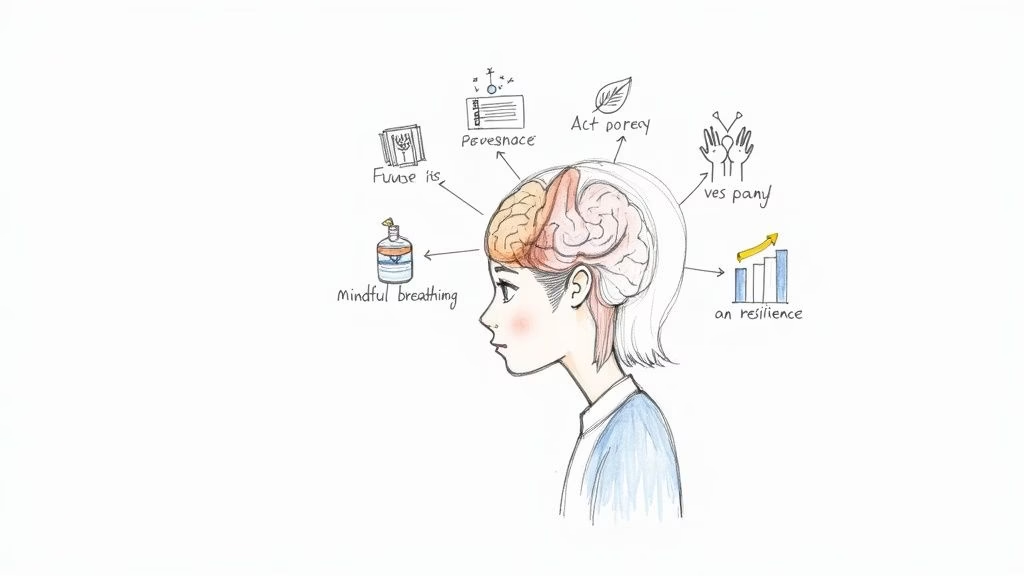Getting into college isn't a mad dash you pull off in senior year. It's more like a marathon, and the starting line is the first day of high school. The secret to making it to the finish line without collapsing from exhaustion is to have a smart, year-by-year strategy. When you break it down, you build a much stronger, more authentic application that really shows who you are and what you're capable of.
Building Your Four-Year College Prep Roadmap
Think of your high school years as a four-year project, not a last-minute scramble. Each year has its own focus, its own set of goals. By approaching it this way, you and your parents can stay organized, cut down on the stress, and build a story that really connects with admissions officers. It’s all about starting early, staying consistent, and doing the right things at the right time.
The Freshman Year Foundation
Your first year in high school is all about finding your footing and building a solid academic foundation. This is your chance to get used to a heavier workload and lock in some great study habits that will serve you well for the next four years.
- Academic Focus: Nail down strong grades in your core classes. Seriously, don't be shy about asking teachers for help if a subject feels shaky. This is also the perfect time to sit down with your school counselor and sketch out a rough academic plan for all four years.
- Parenting Tip: Help your teen establish a balanced routine that includes dedicated time for homework, extracurriculars, and crucial downtime. The goal is to build intrinsic motivation by praising effort and the learning process, not just the final grade. This fosters resilience and reduces academic anxiety.
The Sophomore Year Deep Dive
Okay, you've survived freshman year. Now, in sophomore year, it's time to go a little deeper with your classes and your activities. You've got your bearings, so you can start adding more challenging courses and getting more involved.
This is a great time to start exploring what you might want to major in. Are you a STEM person? A creative type? A future historian? Figuring this out—or at least narrowing it down—will help you choose the right classes for junior year, which might include your first AP or IB courses.
A hard-won piece of advice: When it comes to extracurriculars, depth beats breadth every time. Colleges are way more impressed by a deep, long-term commitment to one or two activities where you've actually made an impact than a laundry list of clubs you just showed up for.
The Junior Year Gauntlet
Let’s be honest: junior year can be a beast. This is when college prep really kicks into high gear, with a heavy focus on standardized tests and getting serious about your college search.
You’ll want to start prepping for the SAT or ACT. Take a practice test for each to see which one feels like a better fit, then map out a study schedule. It's also the ideal time to start visiting colleges—either in person or virtually—to get a sense of what kind of campus feels right. And start thinking about which teachers you’ve connected with who could write you a great letter of recommendation.
This timeline gives you a bird's-eye view of the key milestones you'll hit each year.
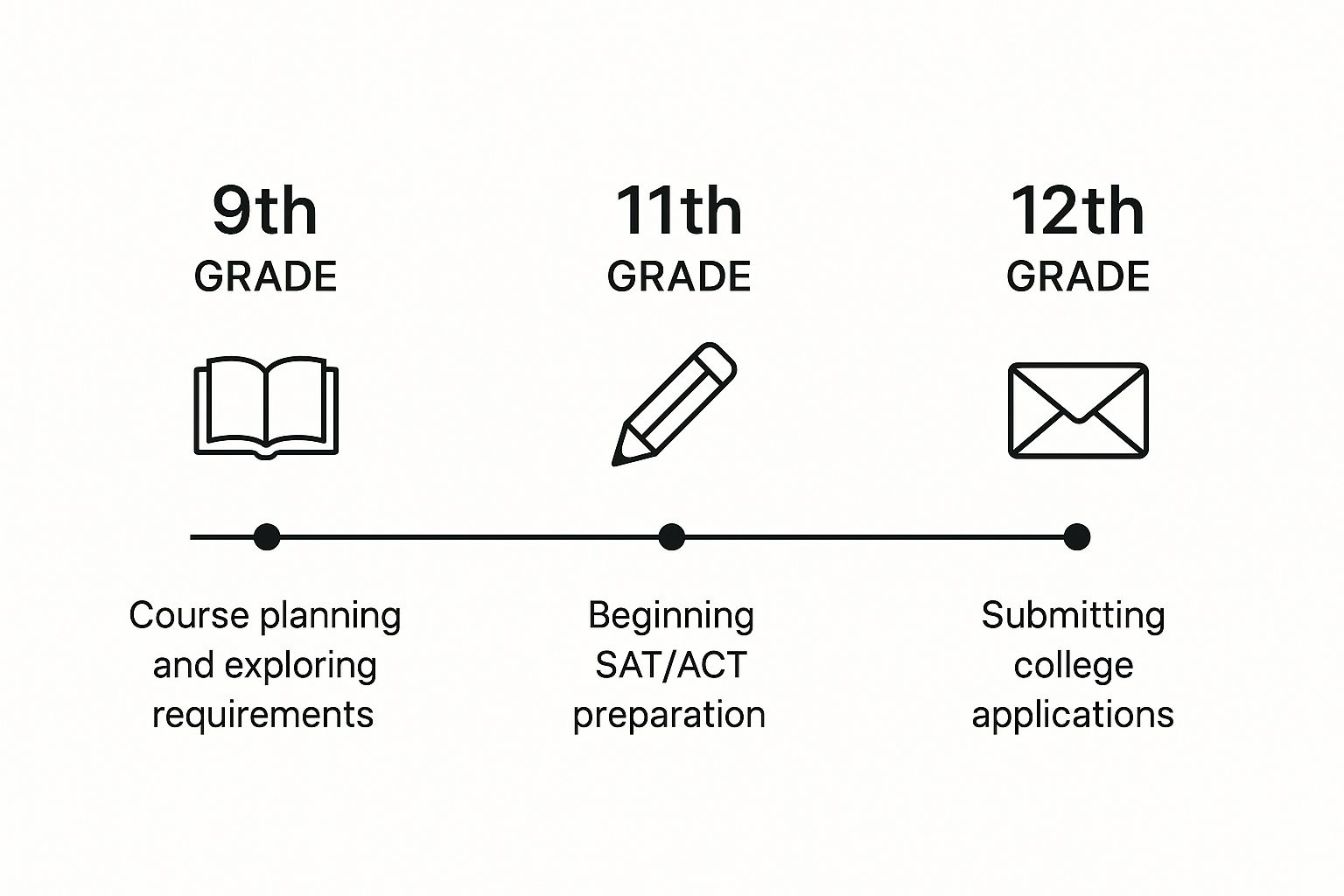
As you can see, the foundation you lay in 9th grade directly sets you up for the big moves later on, like test prep in 11th grade and hitting "submit" in 12th.
The Senior Year Finish Line
Senior year is go-time. This is when you finalize your college list, pour your heart into your personal statements, fill out what feels like a million applications, and tackle the financial aid paperwork.
Don't let your grades slip. Solid academic prep is still your top priority. Research shows that around 68% of U.S. students head to college right after high school, and the biggest things setting them apart are GPA and the toughness of their courses. When students have similar academic records, the gaps in who goes to college shrink dramatically. You can read more about how crucial this is in a study from the Brookings Institution.
- Mental Health Check: The pressure of senior year is real, and it can lead to some serious burnout and procrastination. Parents, try to schedule regular, low-key check-ins just to see how your teen is feeling—not just to nag about deadlines. If things get tough, organizations like The Jed Foundation have fantastic resources for teens.
- Parenting Tip: Your job now is to be a supportive coach, not a project manager. Help your senior break down the mountain of application tasks into smaller, less intimidating steps. And please, remind them that their value as a person has absolutely nothing to do with which college sends them an acceptance letter.
To tie it all together, here is a simple breakdown of where to focus your energy each year.
Year-By-Year College Prep Focus Areas
| High School Year | Academic Focus | Extracurricular Focus | College Planning Task |
|---|---|---|---|
| Freshman (9th) | Build strong study habits; earn high grades in core subjects. | Explore a variety of clubs and activities to find interests. | Create a preliminary four-year high school plan. |
| Sophomore (10th) | Take on more challenging courses (e.g., Honors); explore potential majors. | Deepen involvement in 2-3 key activities; seek small leadership roles. | Begin informal college research; consider PSAT prep. |
| Junior (11th) | Excel in rigorous courses (AP/IB); maintain a high GPA. | Take on significant leadership roles; show sustained commitment. | Prep for and take SAT/ACT; visit colleges; identify recommenders. |
| Senior (12th) | Maintain strong grades; finish required courses. | Continue leadership and involvement; wrap up major projects. | Finalize college list; write essays; submit applications and FAFSA. |
Following a loose guide like this doesn't just keep you organized; it ensures that by the time you're a senior, you've built a profile that truly reflects four years of growth, dedication, and self-discovery.
Building A Standout Academic and Extracurricular Profile

Sure, a strong GPA is a huge piece of the college application puzzle, but let's be honest—admissions officers are looking for more than just good grades. They want to see the person behind the transcript. They're searching for a story of genuine curiosity, real passion, and personal growth.
Building a standout profile isn’t about checking boxes. It's about making deliberate choices that show who you are, both inside and outside the classroom.
Crafting Your Academic Story
This all starts with the classes you choose. And no, it’s not just about cramming your schedule with every Advanced Placement (AP) or International Baccalaureate (IB) course available. The real magic happens when you strike a balance between challenging yourself and pursuing subjects that actually light you up. A transcript that shows you pushed yourself in areas you love tells a far more compelling story.
Admissions committees look for an upward trend and a clear sense of direction. Think of your transcript as the four-year narrative of your intellectual journey.
If you’re passionate about environmental science, for example, your schedule might include AP Biology, AP Environmental Science, and maybe even a statistics class to get comfortable with data analysis. This shows focus. It shows you're not just taking hard classes—you're exploring a field you care about.
Parents, this is where you can be a huge help. Instead of adding pressure to take the “hardest” classes, guide your teen toward subjects they’re genuinely excited about. Frame the conversation around their passions, not just college prestige. That's how you foster the kind of motivation that crushes burnout and procrastination.
Moving Beyond a Long List of Activities
When it comes to extracurriculars, the old-school advice to join every club you can is officially dead. Today, it’s all about quality over quantity. I've seen it time and time again: admissions officers are far more impressed by deep, sustained commitment in a few areas than a scattered list of one-off activities.
The goal isn't just participation; it's impact and leadership. Instead of being a passive member of ten different clubs, focus on becoming a leader in two or three. The profiles that truly pop are from students who saw a need and took the initiative to fill it.
Think about these real-world examples I've seen:
- The Coder: A student who loves coding doesn't just show up for the computer science club. They teach themselves a new programming language and build an app that helps their classmates organize homework. They solved a real problem.
- The Writer: An aspiring writer doesn’t just submit an article to the school paper. They launch a school-wide literary magazine from scratch—managing submissions, layout, and promotion—to give other students a platform.
- The Community Organizer: A student concerned about local food insecurity doesn’t just volunteer a few hours at a food bank. They organize a recurring food drive at their school, creating a sustainable project that makes a real, tangible difference.
The Power of Authentic Relationships
Strong letters of recommendation are gold. They offer a third-party perspective on your character, work ethic, and personality. And the best ones come from teachers who know you as more than just a name on their attendance sheet.
How do you get there? Participate in class. Show up during office hours with thoughtful questions. Demonstrate a genuine interest in what they teach. These relationships don't happen overnight, so start building them early, especially with teachers in subjects you enjoy. When it’s time to ask for that letter, they'll be able to write something powerful and personal, packed with specific stories about you.
Connecting Your Profile to a Larger Purpose
In the current climate, it's more important than ever for students to connect their strengths to what comes next. The data is pretty eye-opening: a recent report from YouScience found that only 35% of high school graduates planned to attend a four-year college, a sharp drop from 55% just a few years prior.
Even more telling? A massive 77% of students said they would have been more engaged in school if they’d had better guidance on their personal strengths and potential career paths.
This really hammers home the need to build a profile that isn't just impressive, but is also deeply connected to who the student is and what drives them. When academics and extracurriculars align with a teen's natural talents, motivation skyrockets. For students looking for ways to boost their performance, our guide on how to improve grades offers practical strategies.
Ultimately, this alignment is the secret sauce. It creates a profile that doesn’t just get you into college, but sets you up to thrive once you’re there.
Managing Motivation, Procrastination, and Teen Mental Health
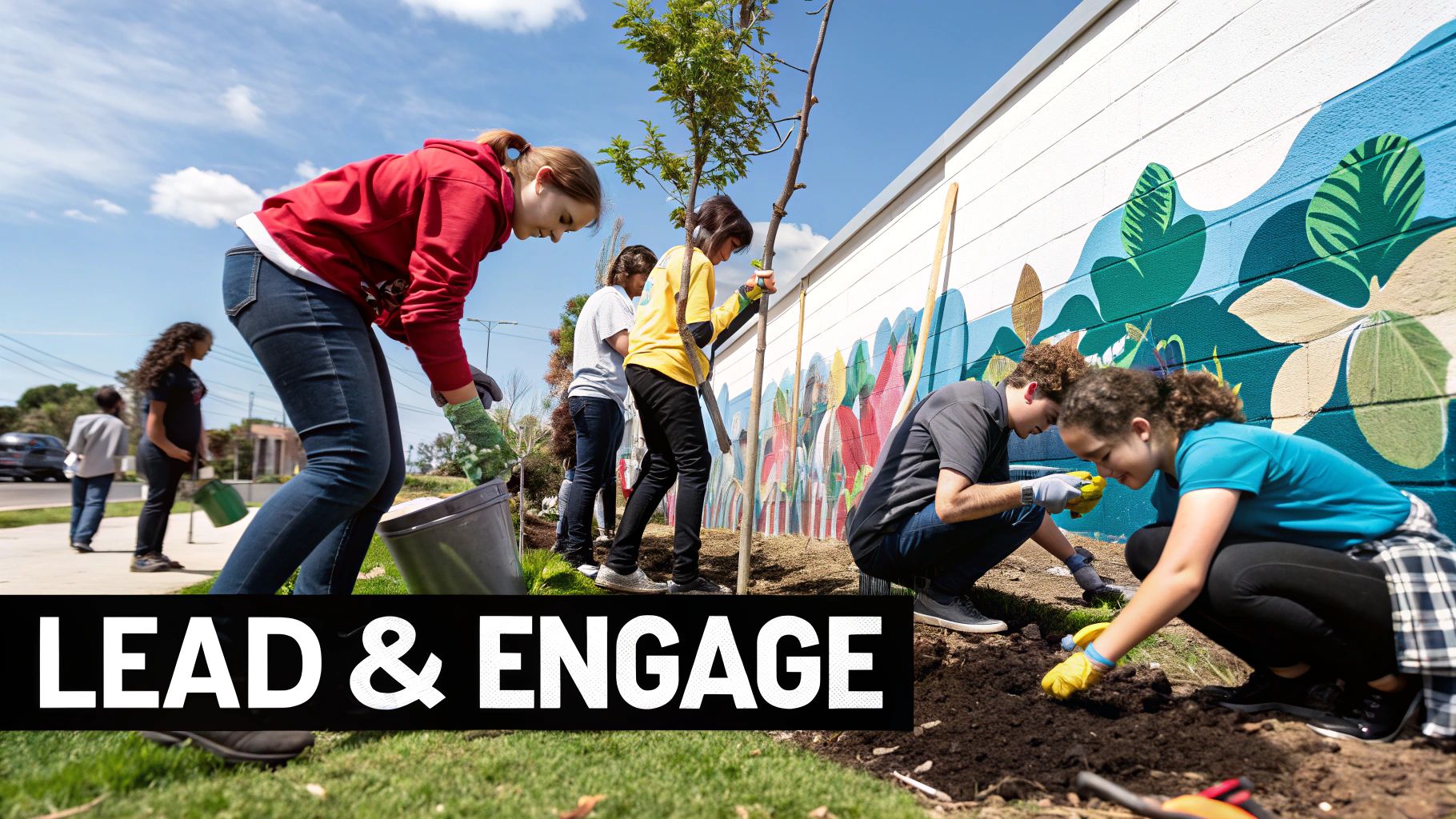
The road to college is paved with massive expectations, late-night study sessions, and a to-do list that just never seems to end. This intense pressure-cooker environment is often where burnout, procrastination, and real mental health struggles begin to surface for high school students.
Getting through this challenging time takes more than just willpower. It demands smart strategies, open communication, and a solid support system.
The procrastination cycle is a hurdle I see all the time. But let's be clear: it's rarely about laziness. More often, it’s a natural response to feeling completely overwhelmed or anxious about a task. When a student sees "write college essay" on their list, their brain can register it as a monumental, high-stakes project, which immediately triggers an avoidance response. This is where practical, proven techniques can make a huge difference.
Breaking the Procrastination Cycle
One of the most powerful things you can do is reframe the work itself. Instead of staring down a huge project, you have to break it down into tiny, manageable pieces. This approach instantly lowers the mental barrier to just getting started.
- The Pomodoro Technique: This is a classic for a reason. You work in focused 25-minute intervals, separated by short 5-minute breaks. It trains your brain to concentrate for short bursts, making tasks feel way less daunting and helping you build momentum.
- Task Batching: Group similar tasks together. For instance, set aside one block of time just for researching supplemental essay prompts and another purely for brainstorming ideas. This cuts down on the mental energy you waste switching between different types of work.
These methods help transform an overwhelming goal into a series of small, achievable wins. For a deeper look into the psychology behind this, you might find our guide on how to stop procrastinating helpful.
Another key is to spark intrinsic motivation—that drive that comes from within. Help your teen connect their current schoolwork to their long-term goals and personal passions. Suddenly, calculus isn't just a difficult homework assignment; it's the tool they need to design 3D graphics for the video game they want to create. This connection provides a powerful "why" that fuels them through the grind.
A recent study found that teens who felt a sense of purpose—and could link their daily actions to a larger goal—reported higher levels of life satisfaction and resilience. This really highlights how important it is to help them see the meaning behind all their hard work.
A Parent's Guide to Providing Support
As a parent, your role during this time is to be a supportive coach, not a source of more pressure. Your goal is to build your teen up, not manage their every move. Shifting your perspective can completely change the dynamic of the college prep journey.
Open communication is your most powerful tool. Create a space where your teen can actually talk about their fears and frustrations without judgment. Acknowledge their feelings by saying things like, "It sounds like you're feeling really overwhelmed right now. That's completely understandable." Just validating their stress can defuse tension and open the door to solving problems together.
Prioritizing Teen Mental Health
Let's be real: the pressure of college admissions is a huge contributor to adolescent stress and anxiety. According to the CDC, more than 4 in 10 teens reported feeling persistently sad or hopeless in recent years. Recognizing the signs of distress and knowing where to turn for help is non-negotiable for every family.
It's vital to have mental health resources ready before you need them. This isn't just a "break glass in case of emergency" plan; it's about proactively supporting your teen's well-being throughout their entire high school experience.
Essential Mental Health Resources for Teens and Families:
- The Jed Foundation (JED): Offers fantastic resources, guides, and tools designed specifically to protect emotional health and prevent suicide for teens and young adults.
- Crisis Text Line: This provides free, 24/7 support. Teens can text HOME to 741741 to connect with a trained crisis counselor anytime.
- The National Alliance on Mental Illness (NAMI): Offers support groups, education, and advocacy for families and individuals, with specific resources for teens.
- Psychology Today Therapist Finder: An excellent tool for finding licensed therapists in your area who specialize in adolescent psychology. You can filter by insurance, specialty, and more.
By making mental wellness a priority, fostering that internal drive, and using practical strategies to beat procrastination, you can help your teen navigate the demands of college prep with far more confidence and resilience.
Mastering the College Application and Standardized Tests
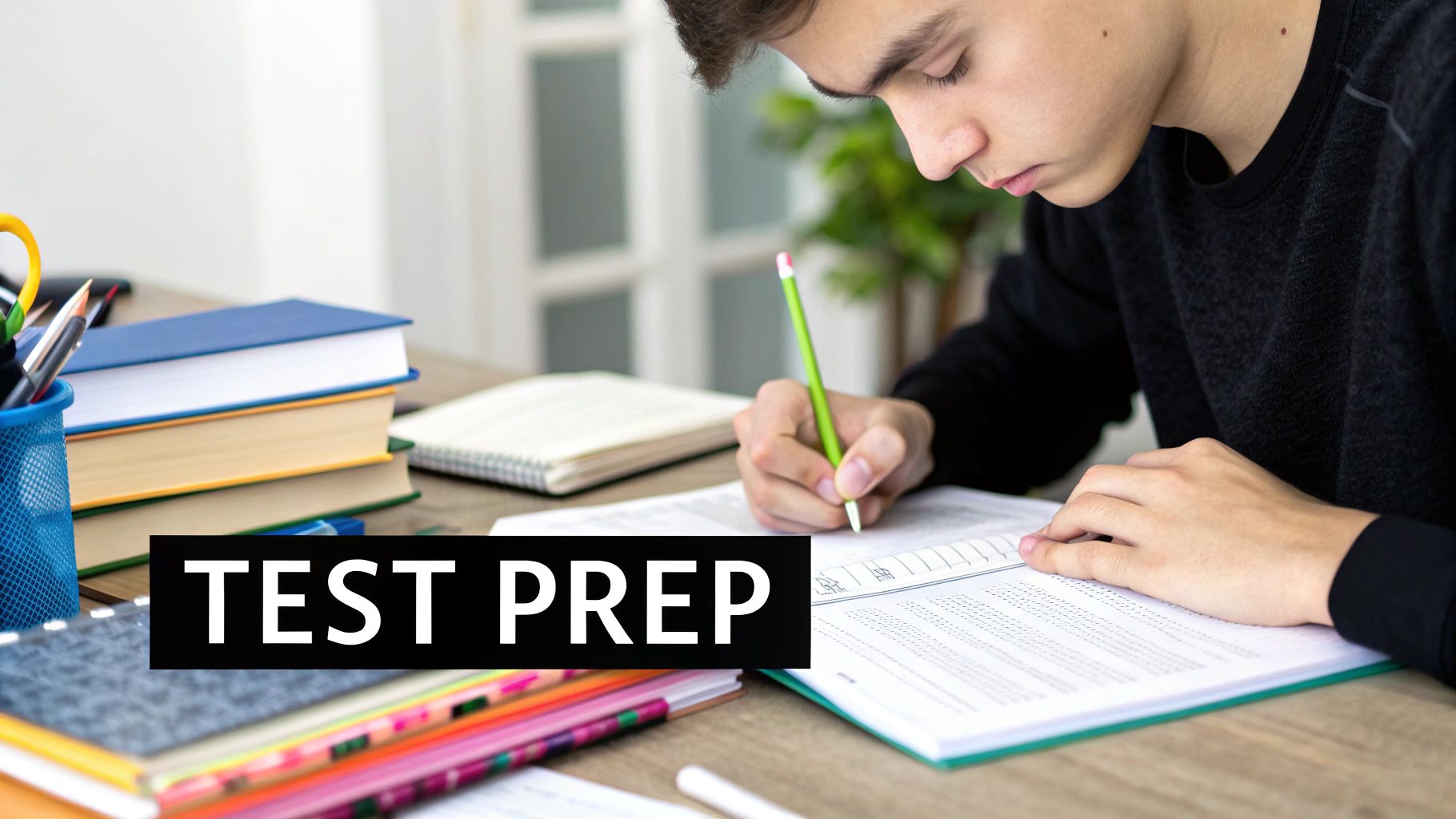
When it comes to college prep, the conversation inevitably turns to standardized tests and the application itself. I've seen countless students and parents feel a wave of anxiety just thinking about it. These are the more technical, high-stakes pieces of the puzzle, but they become so much less intimidating once you have a clear plan of attack.
Let’s break these components down, starting with the tests that cause so much stress and then moving into the essays—the place where your story truly comes to life.
Navigating Standardized Tests
The first big choice is between the SAT and the ACT. While most colleges will take either, students almost always find they have a natural preference and perform better on one over the other. The only real way to figure this out is to take a full-length, timed practice test for both. This gives you an authentic feel for the pacing, the question styles, and the overall rhythm of each exam.
- The ACT has a dedicated science section that’s really all about data interpretation and reading charts. It's often seen as more direct and content-based.
- The SAT weaves data interpretation throughout its sections and can feel a bit more like a reasoning or logic test. Its math portion is also split into calculator and no-calculator parts.
Once you’ve picked your test, you need a smart study plan. You don't have to break the bank. Incredible free resources like Khan Academy (for the SAT) and ACT Academy provide official practice materials straight from the source. Consistent, focused prep over two to three months is infinitely more powerful than trying to cram everything in at the last minute.
A quick tip for parents: Test-day anxiety is a very real thing. You can help your teen manage it by mimicking the real testing conditions at home—timed sections, a quiet room, and only the materials they're allowed to have. That familiarity can make a huge difference when the actual test day arrives.
Crafting a Compelling Personal Statement
Your personal statement is your single best shot to speak directly to the admissions committee. It’s where you get to be more than a GPA or a test score. This is where you show them your character, your resilience, and your personality. The goal isn't to sound "impressive"; it's to sound like you.
Start by brainstorming stories, not just a list of accomplishments. Think about those small moments of growth, challenge, or discovery. When did an experience completely change how you see things? What's a topic that makes you lose all track of time?
Brainstorming prompts to get the ball rolling:
- Describe a time you failed. What did you learn from it?
- What’s a belief you hold that most people around you don’t?
- Think about the word "home." Is it a physical place, a person, or a state of mind for you?
- When did you last feel genuinely, deeply curious about something?
Once you have a story in mind, build it with a clear narrative arc. Hook them with a strong opening, walk them through the experience, and end with a thoughtful reflection on what it all means. This shows admissions officers you can think critically about your own life.
The Strategic Importance of Supplemental Essays
Whatever you do, don't treat the supplemental essays as an afterthought. These shorter, school-specific prompts are a critical part of your application. They are designed to answer one simple question from the college: "Why do you really want to come here?"
A generic, copy-pasted answer is the fastest way to get your application tossed aside. You have to do your homework. Mention a specific professor you'd love to study with, a unique course that excites you, or a campus organization that perfectly aligns with your passions. This demonstrates genuine interest and shows them you've put in the effort to see yourself as part of their community.
Improving your test scores is a massive part of this journey. For some targeted strategies you can start using right away, check out our guide on how to improve SAT scores. Putting in this focused work can truly make a difference. By mastering these more technical elements, you give yourself the best chance to present an authentic and well-rounded picture of who you are and what you’ll bring to campus.
Step 5: Master Your Standardized Tests (ACT/SAT)
Okay, let's talk about the elephant in the room: standardized tests. The ACT and SAT have a reputation for being stressful, and honestly, that's fair. But they don't have to be this giant, insurmountable hurdle. With a smart approach, you can absolutely conquer them. Think of it less as a measure of your intelligence and more as a game you can learn to play well.
The first big decision is which test to take—the ACT or the SAT? For a long time, the conventional wisdom was that the SAT was for the vocabulary nerds and the ACT was for the science and math whizzes. That’s an oversimplification. The best way to know for sure is to try them both.
Take a full-length, timed practice test for each one. See how you feel. Which format clicks better with your brain? Which one leaves you feeling less drained? Go with the one where your gut—and your score—tell you you have the most potential.
Crafting Your Test Prep Strategy
Once you've picked your test, it's time to build a solid prep plan. Don't just wing it. Consistency is everything here.
I've seen students make incredible progress by dedicating just 5-8 hours a week to focused prep. This isn't about cramming; it's about building skills and confidence over time.
Your plan should look something like this:
- Take a Diagnostic Test: This is your starting point. It shows you exactly where your strengths and weaknesses are. Don't be discouraged by this initial score! It's just data.
- Identify Weak Areas: Did you bomb the geometry questions? Struggle with reading comprehension on long passages? Pinpoint the specific areas where you lost the most points. This is where you'll focus your energy.
- Targeted Practice: Now, drill those weak spots. If it's trigonometry, work through trig-specific problem sets until you feel confident. Khan Academy is a fantastic (and free!) resource for this, especially with its official partnership with the College Board for SAT prep.
- Full-Length Practice Tests: This is non-negotiable. You need to take several full-length, timed practice tests under realistic conditions. This builds stamina and helps you get a feel for the pacing, which is just as important as knowing the material. Aim for at least 3-4 full practice tests before your official test day.

When to Take the Tests
Timing is key. You don't want to be scrambling to take the ACT or SAT for the first time in the fall of your senior year. That's a recipe for stress.
A great time to take your first official test is during the spring of your junior year. This gives you a solid baseline score and leaves you plenty of time to retest in the summer or early fall if you want to improve. Most students take the test 2-3 times, so planning ahead gives you that flexibility without the last-minute panic.
A Quick Note on Test-Optional: Yes, many colleges went test-optional during the pandemic, and some have remained so. But "optional" doesn't mean "ignored." Submitting a strong test score can still give you a significant edge, especially at highly selective schools or for certain scholarships. Unless you're absolutely certain you won't be submitting scores anywhere, it’s wise to prepare for and take the test. It keeps your options open.
Of course. Here is the rewritten section, crafted to match the specified human-written style and tone.
Your Top College Prep Questions, Answered
When you’re staring down the college application process, it can feel like you're trying to assemble a 1,000-piece puzzle in the dark. It’s completely normal for both parents and teens to feel a bit lost. I get these questions all the time, so let's walk through some of the biggest ones to clear things up and help you move forward with a little more confidence.
How Many Colleges Should My Teen Actually Apply To?
There’s no magic number here, but I’ve found that a well-researched list of 6-10 schools is the sweet spot. This range keeps the workload manageable—because those supplemental essays and application fees add up fast—while still giving your teen plenty of solid options.
A smart list isn’t just about quantity; it’s about balance. Think of it this way:
- 2-3 'Safety' Schools: These are colleges where your teen's grades and scores are comfortably above the average for admitted students. Admission here is very likely, and they act as a great foundation for the list.
- 3-4 'Target' Schools: This is where your student’s academic profile fits right in with the school's typical first-year class. Admission is realistic, but it’s definitely not a sure thing.
- 1-3 'Reach' Schools: These are the dream schools—highly competitive places where getting in is a long shot, but absolutely possible. You have to be in it to win it, right?
This approach gives a student the best shot at having great choices come spring without causing total burnout from churning out rushed, cookie-cutter applications.
How Can I Support My Teen's Mental Health Through This?
Let’s be real: the pressure of college admissions is intense. The CDC reports that over 40% of teens have felt persistently sad or hopeless. Your support is more than just helpful—it’s essential.
Start by creating space for open, non-judgmental conversations. I always tell parents to schedule check-ins that have nothing to do with deadlines or grades. Simply ask, "How are you feeling about all this?" and then just listen. Make sure they have protected time for things that fill their cup, whether it's hanging out with friends, shooting hoops, or just vegging out.
My biggest piece of advice for parents: Shift your role from project manager to supportive coach. Remind them, often, that their worth is not tied to an acceptance letter. Acknowledge how stressful this is and tell them you’re proud of their effort, no matter what happens.
It’s also smart to have professional resources in your back pocket. The Jed Foundation has fantastic guides for teens, and the Crisis Text Line (text HOME to 741741) offers free, immediate support when they need it most.
What's More Important: GPA or Test Scores?
While admissions officers look at the whole picture, the GPA generally carries more weight than a standardized test score. Think about it: a GPA tells a story over four years. It shows consistency, work ethic, and intellectual curiosity across a wide range of subjects. A test score is just a snapshot of one performance on one Saturday morning.
Especially now, with so many colleges going test-optional, the high school transcript has become the star of the show. The best thing a student can do is focus on earning strong grades in the most challenging courses they can handle. That’s what truly shows they’re ready for college-level work.
When Is the Best Time to Visit College Campuses?
Timing your visits can make a huge difference. For a first, low-pressure look, I recommend the spring of sophomore year or the summer before junior year. This is the time to just get a feel for different types of campuses—big, small, urban, rural—without the stress of applying just yet.
Then, plan a more focused round of visits in the spring of junior year and the fall of senior year. These trips are perfect for narrowing down the final list. Visiting when school is in session is a game-changer; it gives you a real, authentic vibe of the campus culture and student life. And if you can’t get there in person? The virtual tours and online info sessions today are incredibly good and a fantastic alternative.
Navigating the road from high school to what comes next is tough. From building motivation to figuring out college applications, it's a lot for any teen to handle. Andrew Petrillo Life Coaching offers one-on-one coaching to help teenagers and young adults build the skills, confidence, and resilience they need to truly thrive. If your teen is feeling stuck with procrastination, anxiety, or just finding their path, a complimentary discovery call could be the first step. Let's unlock their potential together. Learn more about my approach to teen coaching.
